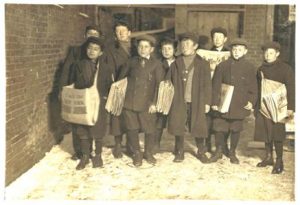ARCHIVAL MOMENT
April 5, 1932
RIOT CAUSES EXTENSIVE DAMAGE TO THE COLONIAL BUILDING

Photo Credit: The Rooms Provincial Archives: A 2-167; Two boys remove a heater during the riot at the Colonial Building. April 5, 1932.
On (April 5, 1932) a crowd gathered in front of the Colonial Building on Military Road, St. John’s to express their concern and displeasure with the manner in which the Richard Squires’ Government was administering the affairs of the Colony.
In 1932, Squires’ finance minister, Peter John Cashin, resigned from the executive council accusing his fellow cabinet ministers of widespread corruption and Squires himself of having falsified council minutes to hide the fact that he had been receiving secret payments out of public funds. Cashin’s charge inflamed a public which had already been seized by discontent due to the deteriorating economic situation in the province.
What had begun as a peaceful demonstration had quickly escalated to a full scale riot. Every window in the building was beaten out; furniture was dragged from the Colonial Building and destroyed on the grounds, and the members of the Government, who were still inside the Building, feared for their lives. The Police responded to the mob with more violence, beating back the rioters with their batons.
The Prime Minister, Sir Richard Squires, barely escaped the building. Though accounts of his escape vary, it seems that he waited until 7:30 that evening when the mob had quieted down and exited the building by the front door to make his way to a waiting car.
Some of the rioters still lingered in the area, and upon recognizing the Prime Minister making his escape, they charged at him and he had to rush into a house on Colonial Street.
Clergy from churches in the area were called; they stood on the steps of the house on Colonial Street exhorting the men to return to their homes. The rioters pursued Prime Minister Squires into the residence, but by the time they had gained entry he had made his escape through the back door.
The result of the riot was a tremendous amount of damage to the Colonial Building, at an estimated cost of $10,000, not to mention the numerous personal injuries which were suffered in the affray.
From 1850 to 1959, the Colonial Building was witness to Newfoundland’s unique political story – from colony to nationhood, from nationhood to the suspension of democracy during the Commission of Government years, and onwards to provincial status within Canada.
Recommended Archival Collection: The Rooms Provincial Archives has a small collection of photographs taken during the riot.
Recommended Museum Visit: At The Rooms Provincial Museum visit the exhibit ‘Here, We Made a Home’ in The Elinor Gill Ratcliffe Gallery – Level 4. This exhibit highlights some of the events associated with the political history of Newfoundland and Labrador.
Recommended Website: http://www.heritage.nf.ca/law/colonial/default.html




![The_Rooms_[1]](http://104.236.223.150/wp-content/uploads/2012/03/The_Rooms_1-167x300.jpg)


